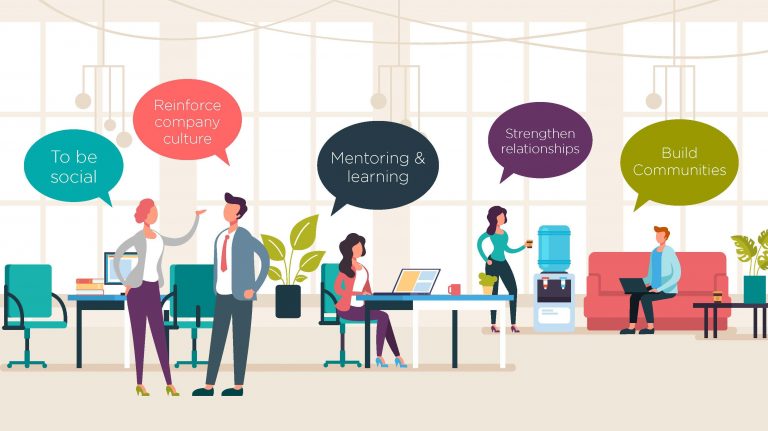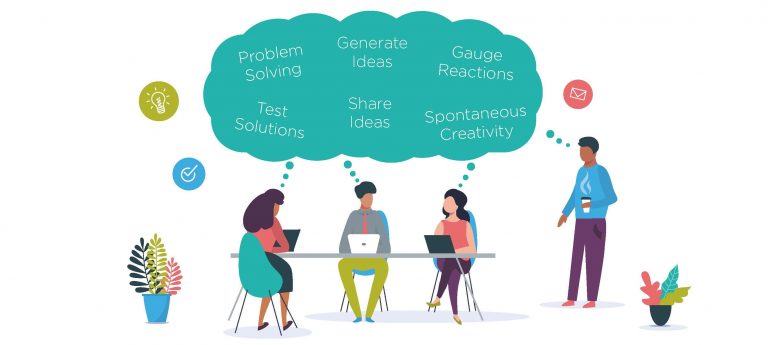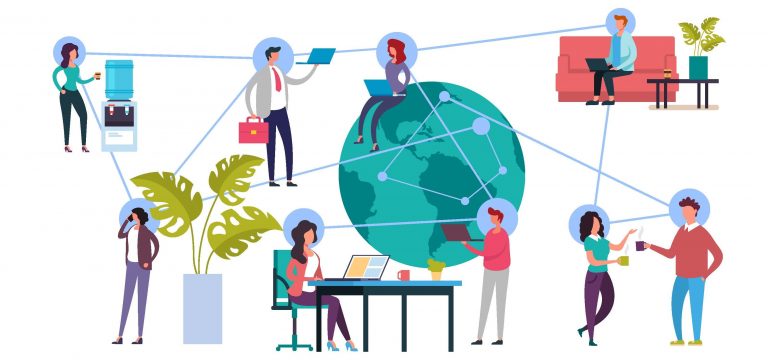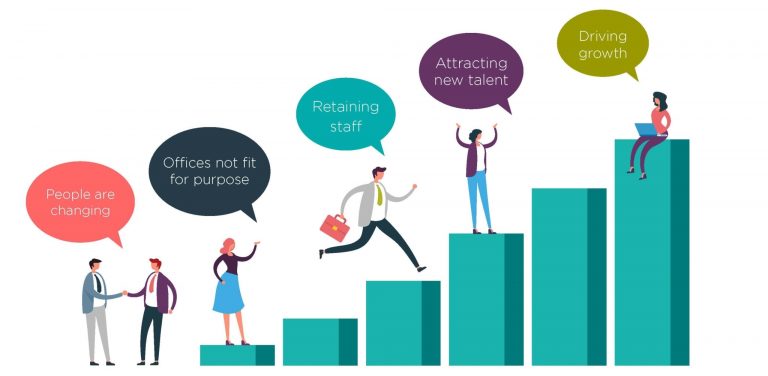What is the future of the office, and how will it be impacted by working from home?
The COVID-19 pandemic has led many organisations and individuals to question the traditional workplace model where people commute every day to centralised offices, often in the centre of large cities and towns. The recent periods of enforced lockdown have caused many people to realise they can work from home, with the potential benefit of an improved work-life balance. As businesses now start to re-evaluate their workplace requirements, many are reviewing what the future holds for their office space.
In this paper, guest author, architect and workplace design specialist Mark Doughty of Chapman Taylor discusses the necessity for dedicated workplaces and explores the way in which employers, landlords and designers will need to adapt the traditional working model to embrace the lessons being learned and to strive for smarter and more agile work practices in the future.

Enhancing the office with more agility and wellbeing-friendly design.
COVID-19: A catalyst for change?
For decades, many people have travelled to and from their offices every day, often because this was the expectation of their employer. Virtually overnight, the recent pandemic has caused many to embrace remote working and both employers and employees are now realising there are potentially some tangible benefits to be gained from evaluating and embracing this model.
For some people, productivity has improved with, for example, fewer distractions when working from home and their commuting time being reallocated to work-focused tasks. Importantly, many people have noted an overall improvement in their work-life balance by managing their working day to accommodate more exercise and time with their families while still meeting their work requirements.
Conversely, some people have found their productivity has fallen, often because they have no suitable space to work, or because effective collaboration with their colleagues is simply not replicable over video conferencing, especially while juggling childcare arrangements or sharing home-working space with their partners or flatmates. The realisation for many is that the pandemic has underlined the importance of their workplace and, in particular, the non-work-related interactions that often happen there.
We should therefore expect to see more flexible ways of working in the future to address the needs of both the employer and employee. While many companies already offered a flexible working approach, the pandemic will accelerate a global change in workplace culture that looks to maximise the benefits of both the physical workplace and virtual remote working.
Why is the workplace important?
The office environment provides businesses and organisations with the opportunity to express their culture, strengthen relationships, be social and, ultimately, build a team-based community of people with a common set of objectives.
Mentoring of our younger staff, the future generations of our businesses, is also key within the office, not just for employers, but also for the development of the individuals themselves. Speaking from personal experience, I learned most of what I know by listening to, and learning from, those around me – picking up on snippets of telephone conversations or collaborating with peers. This does not happen when working in isolation. The office provides real life experiences and the ability to put into practice what has been learnt while still being able to draw on support from colleagues.

The many benefits of company workplaces.
The office is also a destination, a reason to get out of bed every day, providing a much-needed structure to the working week. While, for some, commuting can be laborious, and time could potentially be better allocated to work-related tasks, the act of travelling to and from the office can often provide a valuable period of transition that contributes positively towards a more balanced state of mental wellbeing.
For creative businesses like ours, collaboration is a key part of our work. The office creates the opportunity to generate and share ideas collaboratively, solve problems, test solutions and immediately gauge people’s reactions. Evidence shows that many great innovations and creative sparks often happen almost accidentally within the workplace, or in the support spaces therein (e.g. the kitchen or breakout areas). These chance meetings are difficult to replicate on Zoom or MS Teams.

Getting around a table with colleagues is an invaluable creative opportunity.
Striking a balance: Smart Working
We should recognise that more people than ever are now choosing to work remotely for some of the time (up from an estimated 20% pre-pandemic to over 50% currently in the UK) and, for some, things will not just return to the way they once were. Some people have been required to work from home in line with the Government’s or their employer’s guidance and will happily wish to return to the office once the pandemic restrictions are relaxed. Others are likely to want to use this period of remote working to re-evaluate how they wish to work in the future.
Many businesses, including ours, have started to review their office space requirements, and some may conclude that they can relinquish space if a significant number of their employees are able, and willing, to work remotely. If this flexible approach is planned and well-managed, it will present businesses with an opportunity to become more agile and attract talent from beyond the geographical location of their workplace. Of equal importance, their growth will no longer be limited by their physical tenant demise.
From an employee’s perspective, potential improvements in health and wellbeing and a better work-life balance will be a catalyst for this change. However, I strongly believe that the future of the workplace, and of workplace culture, lies in the balance to be struck between the needs of both the employer and their teams, i.e. Smart Working.

Embracing digital connectivity to redefine the physical limits of the workplace.
First and foremost, businesses must function efficiently and effectively to be successful. The need for well-designed office space will continue to be vital to support an organisation’s dynamism and ability to collaborate and to host those all-important social and chance interactions with likeminded people. However, we should anticipate that changes to our workplace environments (both existing and new) will evolve more rapidly to support business culture while offering a smarter, more flexible and more attractive way of working for both employers and employees.
We also need to accept that some changes to the way we work may not suit everybody, so, however we choose to work in the future, we need to avoid a one-size-fits-all approach as well as any preconceived ideas about how people wish to work. We are all individuals with differing personal and business circumstances which change throughout our careers, and this will influence how we wish to work in the future. Working collaboratively with their employees, businesses will need to focus on evolving an office culture and environment that supports flexible working in a variety of ways.

What does this mean for the future of workplace design?
While we are some way off being “post-pandemic”, it is clear that the way we design or curate workplaces in the future should be with a view to being flexible and to meeting the specific needs of the people who work there. People are individuals with diverse needs, priorities and expectations. To avoid any preconceptions, the first step is to undertake a wide-ranging staff survey to collect accurate data and understand what is important to the people in the business. This can then be used to evolve a new workplace culture and allow us to deliver effective workplace design solutions.
As businesses re-evaluate their workspace requirements, one trend we are likely to see is a shift away from large, centralised office hubs in major cities, to a series of smaller satellite – or touchdown – spaces in more suburban and regional locations closer to where people live. These will provide the obvious benefit of reducing commuting times while also reducing the financial burden of occupying large swathes of premium office space in the centres of large cities.
Provision of more affordable, quality “local” office space as part of mixed-used town centre developments on the outskirts of primary cities will be key in the drive to regenerate our failing town centres while also reducing travel. These satellite office spaces could also be achieved using local co-working hubs, with subscriptions, to provide a degree of mobility and a choice of where to work.

Design for agility – a range of workplace environments for a range of different needs.
The current COVID crisis is a moment in time and is likely to become a distant memory in a few years. With vaccines now beginning to be distributed in the UK, things will soon begin to return to normality. However, it is important that the “new normal” does not simply revert to a pre-pandemic way of working and miss out on the opportunity to embrace the positive things we have learned about the way we can work more flexibly. We need to use our recent experience as a catalyst for positive changes to the way we work and use our workplaces, including the use of available and upcoming technologies and a renewed focus on health, wellbeing and the environments we work in.
Workplaces have never been just places to work; they are places for people to collaborate, to socialise, to mentor and learn and to foster health and wellbeing. For designers, our challenge is to ensure that the workplaces we design offer a stimulating environment to facilitate all these activities.
The new era of office needs to accommodate a wide variety of workspaces such as one-to-one meeting rooms, training areas, formal and informal collaboration spaces, and sit-stand desking. The key is to design these spaces to be as adaptable as possible and to facilitate more than one use.
Health and Wellbeing are now fundamental design considerations for architects, interior designers, developers, and tenants. Maximising natural light, the use of natural ventilation, designing in active circulation routes, providing abundant planting, and using biophilic and non-toxic materials are essential. New accreditations such as the WELL Building Standard will also become commonplace as tenants reinforce their commitment towards health and wellbeing of their staff.
Why is change important?
As businesses begin to repopulate their workspaces, they may find that the way their offices are accessed, how circulation routes work and how the space is utilised, is no longer fit for purpose. This realisation could be a catalyst for undertaking major improvements to their work environment to create a new generation of safer, healthier, more flexible, and enjoyable spaces for staff to spend their time working in the offices as effective as possible.
The quality of the workplace is also an increasingly important factor in attracting and retaining the best talent in a business. Many successful businesses are already thinking in this way, and those who do not embrace Smart Working practices in the future will run the risk of becoming less attractive and competitive in what is a fast-changing and fluid employment landscape.

Reasons to embrace Smart Working.
What is our aim at Chapman Taylor?
Our workplace team are currently conducting an extensive internal R&D study with our teams to help our understanding of “How do we want to work in the future?”.
Our starting point for this is a comprehensive survey of our staff with a series of pertinent workplace-related questions that will provide greater insight into the needs and aspirations of our colleagues and to help inform how we evolve the design of our studios and develop a Smart Working culture in the coming months and years.
Our objective is to refine our workplace environments, to work smarter, but most importantly to continue to embrace and respect Chapman Taylor’s core values and of servicing the needs of our clients to the best of our ability, within a strong and creative environment.

About the Author
Architect – Chapman Taylor
Mark joined Chapman Taylor in 2006, becoming an Associate Director in 2016. A key member of the management team, Mark holds a remit for the office workplace sector across the UK. He has over 10 years’ experience and has successfully completed a number of major award winning projects.



